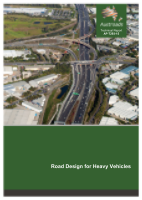Road Design

- Publication no: AP-T293-15
- ISBN: 978-1-925294-39-2
- Published: 1 May 2015
- PDF (free) Download
Heavy vehicle crashes across Australia and New Zealand continue to be a major road safety issue. There are road design criteria that are not based on the requirements of heavy vehicles and the purpose of this study was to update criteria for intersections to accommodate heavy vehicles. The study examined gap selection at a variety of intersection layouts including two lane and four lane intersections. The results provided a reasonable measurement of the gap sizes due to the low number of heavy vehicles undertaking movements through the intersections.
Consultation with industry stakeholders identified a number of matters that concern the heavy vehicle operators. The key matters were difficulty in negotiating small roundabouts due to swept path, proximity of roadside furniture and length of merge lanes to reach the speed limits.
- Summary
- Contents
- 1. Introduction
- 1.1. Background
- 1.2. Objectives
- 2. Methodology
- Stage 1
- Stage 2
- Stage 3
- 3. Gap Selection
- 3.1. Introduction
- 3.2. Scope
- 3.3. Method
- 3.3.1. Heavy Vehicle Classes
- 3.3.2. Definition of a Car
- 3.4. Subject Sites
- 3.5. Data Collection
- 3.6. Data Processing
- 3.6.1. Heavy Vehicles
- 3.6.2. Cars
- 3.7. Data Analysis Methods
- 3.7.1. Greenshields Method
- 3.7.2. Raff Method
- 3.7.3. Logit Method
- 3.8. Results for Heavy Vehicles
- 3.8.1. Greenshields and Raff Methods
- 3.8.2. Logit Method
- 3.8.3. Discussion – Heavy Vehicles
- 3.9. Results for Cars
- 3.9.1. Greenshields and Raff Methods
- 3.9.2. Discussion – Cars
- 4. Literature Review
- 4.1. Road Geometry
- 4.1.1. Turning Radius
- 4.1.2. Driver Eye Height
- 4.1.3. Sight Distances
- 4.1.4. Intersection Sight Distance
- 4.1.5. Lane Width
- 4.1.6. Horizontal Curves
- 4.1.7. Alignment and Grade
- 4.1.8. Shoulder Sealing
- 4.1.9. Roadside Hazards
- 4.1.10. Carriageway Types
- 4.1.11. Level Crossings
- 4.2. Traffic Control
- 4.2.1. Traffic Control at Intersections
- 4.2.2. Signage
- 4.2.3. Delineation
- 4.3. Other Issues
- 4.3.1. Pavement Surface
- 4.3.2. Rest Areas
- 4.3.3. Service Roads
- 5. Crash Analysis
- 5.1. Heavy Vehicle Fatal Crashes and Fatalities in Australia
- 5.1.1. Articulated Trucks
- 5.1.2. Rigid Trucks
- 5.1.3. Buses
- 5.1.4. Total Heavy Vehicle Crashes across Australia
- 5.2. Heavy Vehicle Fatal Crashes and Fatalities in New Zealand
- 5.3. Australia and New Zealand Comparison of Heavy Vehicle Fatal Crashes and Fatalities
- 5.3.1. Trucks
- 5.3.2. Buses
- 5.3.3. Total Heavy Vehicles
- 5.4. Characteristics of Heavy Vehicle Casualty Crashes
- 5.4.1. Time-of-day
- 5.4.2. Day-of-week
- 5.4.3. Month
- 5.4.4. Crash Type
- 5.4.5. Light Conditions
- 5.4.6. Weather Conditions
- 5.4.7. Road Surface Condition – Wet/Dry
- 5.4.8. Road Surface Condition – Sealed and Unsealed
- 5.4.9. Speed Zone
- 5.4.10. Horizontal Road Alignment
- 5.4.11. Type of Intersection
- 6. Consultation
- 6.1. Background
- 6.2. Workshops and Consultations
- 6.3. Workshop Findings
- 6.3.1. Intersections
- 6.3.2. Road Lengths
- 6.3.3. Stopping Places
- 6.3.4. Other
- 6.4. Survey Findings
- 7. Austroads Guide to Road Design
- 8. Conclusions and Next Steps
- 8.1. Gap Selection
- 8.1.1. Heavy Vehicles
- 8.1.2. Cars
- 8.2. Review of Literature
- 8.3. Crash Data
- 8.3.1. Fatal Crashes and Fatalities
- 8.3.2. Crash Data – Trends in Casualty Crashes
- 8.4. Consultation with Key Stakeholders
- 8.5. Review of the Austroads Guide to Road Design
- References
- Appendix A Data Collection Sites
- A.1 Site 1 – Burgess Road and Dorset Road, Kilsyth, Victoria
- A.2 Site 2 – Gilbert Park Drive and Ferntree Gully Road, Knoxfield, Victoria
- A.3 Site 3 – Abbott Road and Hallam South Road, Hallam South, Victoria
- A.4 Site 4 – Centre Road and Hallam South Road, Hallam South, Victoria
- A.5 Site 5 – Lytton Road, Lindum Road and Gosport Street, Lindum, Queensland
- A.6 Site 6 – Port Drive and Tanker Street, Lytton, Queensland
- A.7 Site 7 – Lytton Road and Pritchard Street, Lytton, Queensland
- A.8 Site 8 – Lytton Road and Canberra Street, Hemmant, Queensland
- Appendix B Video Data Reviewed
- Appendix C Graphical Results: Heavy Vehicle Drivers
- C.1 Left Turns from Minor Road onto a Two Lane Major Road
- C.2 Left Turns from Minor Road onto a Four Lane Major Road
- C.3 Right Turns from Minor Road onto a Two Lane Major Road
- C.4 Right Turns from Minor Road onto a Four Lane Major Road
- C.5 Right turns from Major Road onto a Two Lane Road
- C.6 Right turns from Major Road onto Four Lane Road
- C.7 Crossing a Major Four Lane Road
- Appendix D Graphical Results: Car Drivers
- Appendix E Stakeholder Participants
- Appendix F Workshop Questions/Questionnaire
- Appendix G Workshop Findings
- Appendix H Responses to Questionnaire Survey
